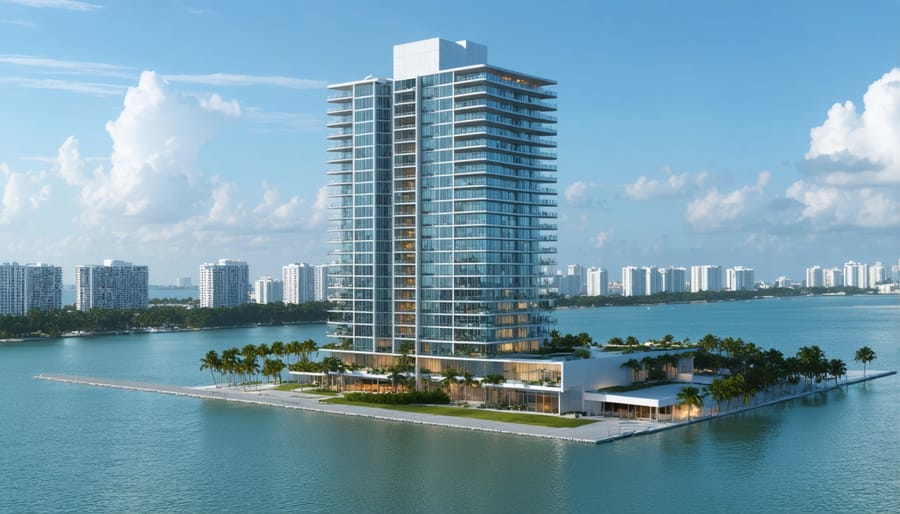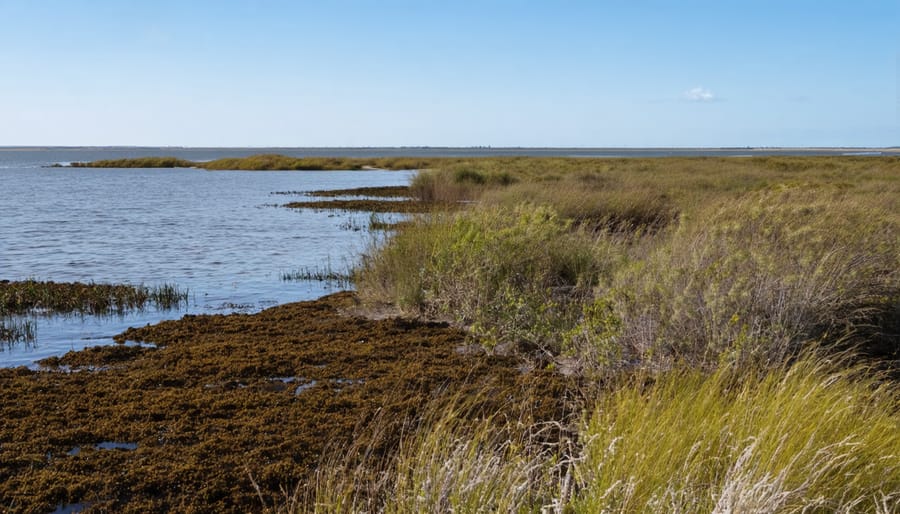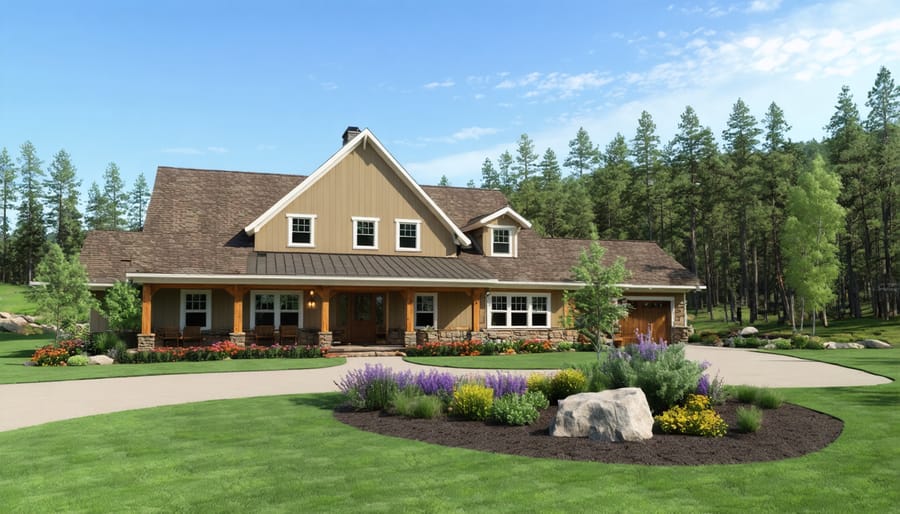Building climate resilience requires strategic adaptation across multiple property types and sectors, with proven examples demonstrating remarkable success in protecting assets and communities from extreme weather events. From Miami’s innovative stormwater management systems to Amsterdam’s floating neighborhoods, forward-thinking cities and property owners are revolutionizing how we future-proof your real estate against climate challenges.
Consider New York City’s post-Hurricane Sandy transformation, where elevated electrical systems, reinforced building envelopes, and green infrastructure now protect billions in real estate value. These adaptations have reduced insurance premiums by up to 30% while increasing property values in previously vulnerable areas. Similarly, California’s wildfire-resistant construction methods and defensive landscaping techniques have become essential models for at-risk communities nationwide.
These real-world examples prove that climate resilience isn’t just about survival—it’s about creating smarter, more valuable properties that thrive despite environmental challenges. Whether you’re a property owner, investor, or developer, understanding and implementing these tested strategies is crucial for long-term asset protection and appreciation.
Urban Properties Leading the Climate Defense
Flood-Ready High-Rises in Miami
Miami’s forward-thinking developers are revolutionizing high-rise design with innovative flood resilience features that serve as a blueprint for coastal urban development. The Brickell City Centre complex exemplifies these eco-friendly property improvements, incorporating elevated electrical systems 30 feet above ground level and sophisticated stormwater management systems capable of handling intense rainfall events.
One standout example is the recently completed Monad Terrace, which sits 11.5 feet above sea level, significantly higher than Miami’s standard requirements. The building features a unique reflection pool that doubles as a stormwater retention system, capable of managing up to 190,000 gallons during severe weather events.
The Paramount Miami Worldcenter takes flood resilience even further with its “smart” foundation design. The structure employs advanced water sensors and automated flood barriers that activate during storm surges. Critical systems, including backup generators and mechanical equipment, are strategically placed on higher floors, ensuring continuous operation during flooding events.
These developments also incorporate specialized insurance benefits for residents, with some buildings qualifying for reduced flood insurance premiums due to their resilient design features. This approach not only protects the physical asset but also offers significant long-term cost savings for property owners, demonstrating how climate-ready design can deliver both safety and financial benefits.

Heat-Resistant Developments in Phoenix
Phoenix developers and property owners are leading the charge in heat-resistant building innovations, responding to the city’s increasingly extreme temperatures. The Bullitt Center exemplifies this trend with its advanced thermal management system, combining automated external shading devices with phase-change materials in the walls that absorb heat during peak hours and release it at night.
Local architects have embraced cool roof technology, with developments like CityScape incorporating high-albedo roofing materials that reflect up to 85% of solar radiation. These materials have shown to reduce cooling costs by 20-30% during summer months while extending roof lifespan by up to 15 years.
Desert-adapted landscaping plays a crucial role in several new developments. The Burton Barr Central Library uses strategically placed desert vegetation and shade structures to create cooling microenvironments, reducing ambient temperatures by up to 10°F in surrounding areas. The building’s double-skin facade system creates an air cushion that naturally regulates internal temperatures.
Recent residential developments have implemented innovative cooling solutions like the ICE system (Integrated Cooling Environment), which combines traditional HVAC with passive cooling features. The Optima Kierland development showcases hanging gardens and vertical landscaping that provide natural insulation while reducing the urban heat island effect.
These adaptations not only improve comfort but also translate to significant cost savings, with many buildings reporting 25-40% reductions in cooling-related energy expenses compared to conventional structures.
Coastal Property Solutions That Work

Living Shorelines in Action
Living shorelines represent one of the most effective natural approaches to protecting coastal properties from rising seas and intense storms. Rather than relying on traditional hardened structures like seawalls, property owners are increasingly turning to restored wetlands, oyster reefs, and native vegetation to create resilient coastal barriers.
In Florida’s Tampa Bay area, several waterfront communities have successfully implemented living shoreline projects. One notable example is a residential development that replaced failing bulkheads with a graduated slope of native marsh grasses and mangroves. This natural barrier not only protects against storm surge but has also improved water quality and created habitat for local wildlife.
Another success story comes from Charleston, South Carolina, where a historic waterfront property integrated oyster reef restoration with salt marsh creation. The project has demonstrated remarkable effectiveness during recent hurricanes, with significantly less flood damage compared to neighboring properties using conventional seawalls.
These natural solutions typically cost 30-50% less than traditional hardened infrastructure while providing additional benefits like improved property values and reduced insurance premiums. Maintenance costs are also generally lower, as these systems can self-repair and adapt to changing conditions over time.
For coastal property investors, living shorelines offer a sustainable, long-term approach to climate resilience that aligns with both environmental stewardship and financial objectives. Many states now offer grants and tax incentives for implementing these natural solutions, making them an increasingly attractive option for shoreline protection.
Storm-Smart Architecture
Modern storm-smart architecture has revolutionized how we build in hurricane-prone regions, combining innovative design with practical resilience. The Fortress House in Florida’s Key West stands as a prime example, featuring a distinctive aerodynamic roof design that reduces wind uplift and impact-resistant windows rated for Category 5 hurricanes. Its elevated structure, sitting 12 feet above sea level, protects against storm surge while maintaining aesthetic appeal.
In Miami, the recently completed Grove at Grand Bay towers showcase how luxury properties can incorporate climate resilience. These twisting glass towers utilize a sophisticated dampening system to counteract high winds, while their foundations extend deep into bedrock for enhanced stability. The buildings’ glass facades are equipped with laminated impact windows that can withstand flying debris at speeds up to 175 mph.
Coastal developments like Charleston’s New Cooper River Bridge District demonstrate community-scale resilience. Buildings here feature breakaway wall systems on ground floors, allowing storm surge to flow through without compromising structural integrity. Strategic landscaping with native vegetation creates natural buffers against wind and water.
Beyond individual features, these structures incorporate redundant systems for critical functions. Backup power generators are positioned above flood levels, and mechanical systems are strategically placed on upper floors. These design choices not only protect inhabitants but also significantly reduce insurance premiums and maintenance costs over time, making them attractive investments for property owners and developers.
Rural Property Innovations
Wildfire-Resistant Ranch Homes
In California’s fire-prone regions, innovative ranchers and homeowners are setting new standards for wildfire-resistant construction. The Martinez Ranch in Sonoma County showcases several key resilience features, including a Class A fire-rated metal roof, cement fiber siding, and dual-pane tempered glass windows. The property maintains a 100-foot defensible space through strategic landscaping with fire-resistant native plants and gravel barriers.
In Montana, the Peterson Family Ranch implemented a comprehensive fire-protection strategy after narrowly surviving the 2017 wildfire season. Their improvements include ember-resistant vents, fire-resistant deck materials, and an advanced sprinkler system that can be activated remotely. The ranch’s innovative gutter design prevents leaf accumulation, reducing fuel sources near the structure.
The Wilson Ranch in Colorado demonstrates cost-effective solutions, combining traditional ranch architecture with modern fire-resistant materials. Their insurance premiums decreased by 25% after implementing these improvements, which included boxing in eaves, installing ember-proof mesh screens, and creating strategic firebreaks around essential structures. The property’s design proves that fire resilience can be achieved while maintaining the authentic aesthetic of ranch architecture.

Drought-Ready Farm Properties
Modern drought-ready farms showcase innovative water conservation systems that maximize agricultural productivity while minimizing water usage. In California’s Central Valley, the Anderson Family Farm utilizes state-of-the-art drip irrigation combined with soil moisture sensors, reducing water consumption by 40% compared to traditional farming methods. Their computerized irrigation scheduling system responds to real-time weather data and crop needs.
The Desert Rose Ranch in Arizona demonstrates excellence in water-efficient agriculture through its closed-loop water recycling system. The property captures and filters agricultural runoff, storing it in underground cisterns for future use. Their shade structures and strategic crop placement minimize evaporation, while drought-resistant crop varieties ensure continued productivity during dry periods.
In Texas, the Green Mesa Farm employs precision agriculture techniques, including GPS-guided equipment and drone monitoring to optimize water distribution. Their rainwater harvesting system can capture up to 100,000 gallons during rare rainfall events, supplementing their groundwater resources. The property’s xeriscaping and native vegetation borders further reduce water requirements while supporting local biodiversity. These water-conscious design elements have increased the property’s market value and reduced annual operating costs by 30%.
Financial Benefits of Climate Resilience
Insurance Premium Reductions
Property owners who implement climate resilience measures are increasingly seeing substantial reductions in their insurance premiums, creating a compelling financial incentive for adaptation. In Florida, a homeowner in Miami Beach saw their annual premium drop by 25% after installing impact-resistant windows, hurricane straps, and a reinforced roof system rated for 150 mph winds. The total investment of $32,000 paid for itself within six years through insurance savings alone.
In California’s wildfire-prone regions, a commercial property owner achieved a 30% reduction in insurance costs by implementing comprehensive fire defense measures. These included installing ember-resistant venting, creating defensive space around buildings, and upgrading to fire-resistant roofing materials. The annual savings exceeded $45,000 across their property portfolio.
A striking example comes from a Texas apartment complex that reduced its flood insurance premiums by 45% after elevating critical systems, installing flood barriers, and implementing a comprehensive stormwater management system. While the initial investment reached $200,000, the resulting insurance savings combined with reduced flood damage risk created a positive return on investment within four years.
Small businesses are also benefiting from this trend. A retail strip mall in New Orleans documented a 35% decrease in insurance costs after installing flood-resistant doors, elevating electrical systems, and implementing a green roof system for improved stormwater management. These modifications not only reduced insurance costs but also enhanced property value and tenant satisfaction.
Enhanced Financing Options
Recent case studies reveal how climate-resilient properties are securing more favorable financing terms, creating a win-win situation for property owners and lenders alike. For example, the Oceanview Apartments in Miami Beach achieved a 0.25% reduction in their mortgage rate after implementing comprehensive flood protection measures and hurricane-resistant windows, saving over $150,000 annually in financing costs.
Similarly, a commercial development in Phoenix secured preferential lending terms by incorporating solar panels, smart irrigation systems, and heat-resistant building materials. The property’s enhanced resilience features resulted in a 15% lower insurance premium and qualified for specialized green financing options, reducing their overall operating costs by 22%.
In Seattle, the Evergreen Office Complex demonstrated how climate adaptation measures could influence property valuation. After installing bioswales for flood management and upgrading to a smart HVAC system, the property’s appraised value increased by 12%, leading to more favorable refinancing terms with their lender.
Rural properties are also benefiting from this trend. A farming estate in California’s Central Valley secured better lending terms by implementing drought-resistant irrigation systems and maintaining natural windbreaks. Their comprehensive climate resilience plan resulted in a 0.375% reduction in their agricultural loan rate.
These examples highlight a growing recognition among lenders that climate-resilient properties represent lower risk investments. Properties with documented resilience features are increasingly eligible for reduced interest rates, extended loan terms, and higher loan-to-value ratios, making sustainable improvements financially advantageous for property owners.
As we look to the future of real estate, climate resilience has become not just a desirable feature but a crucial investment strategy. The examples we’ve explored demonstrate that implementing climate-resilient measures can significantly enhance property values while protecting assets against environmental challenges.
The financial sector is increasingly recognizing climate resilience as a key factor in property valuation and insurance rates. Properties with robust climate adaptation features are securing better insurance terms and higher resale values, creating a compelling business case for early adoption of resilient design principles.
Looking ahead, we can expect climate resilience to become a standard consideration in real estate transactions. Forward-thinking investors and homeowners who implement these measures now will likely see substantial returns as markets continue to factor climate risks into property valuations. Insurance companies are already offering preferential rates for properties with proven resilience features, a trend that’s expected to accelerate.
The key takeaway is clear: climate resilience is no longer optional in real estate. Whether through green infrastructure, flood protection measures, or energy-efficient systems, properties that adapt to climate challenges will maintain their value and marketability in an increasingly unpredictable environment. As extreme weather events become more frequent, the investment in climate resilience today will pay dividends in both property protection and financial returns tomorrow.
Remember, the best time to implement climate resilience measures is before they’re needed. Start planning your property’s climate adaptation strategy now to stay ahead of market demands and environmental challenges.